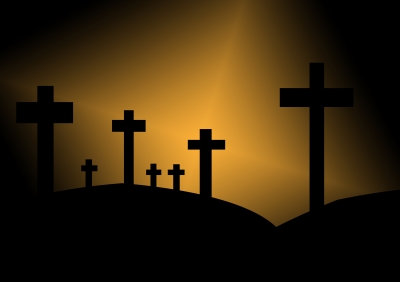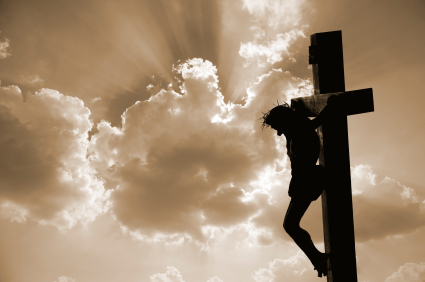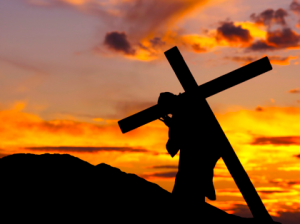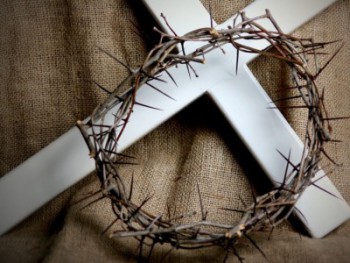Did Jesus Christ Rise from the dead?
Lorem ipsum dolor sit amet, consectetur adipiscing elit. Ut elit tellus, luctus nec ullamcorper mattis.
Fact #2: Jesus Christ died on a Roman Cross by Crucifixion

The Gospels confirm Jesus’ death on the Cross
All four Gospel accounts establish the fact of Jesus Christ’s death was on a Roman cross and almost every book in the New Testament either mentions or alludes to the reality of His death on a cross. “When they had scourged Jesus, he (Pilate) delivered Him to be crucified. Then the soldiers of the governor took Jesus into the Praetorium and gathered the whole garrison around Him. And they stripped Him and put a scarlet robe on Him. When they had twisted a crown of thorns, they put it on His head and a reed in His hand. And they bowed the knee before Him and mocked him saying Hail, King of the Jews. Then they spat on Him and took the reed and struck Him on the head. And when they had mocked Him, they took the robe off Him, put His own clothes on Him and led Him away to be crucified. Now as they came out, they found a man of Cyrene, Simon by name. Him they compelled to bear His cross” . – Matthew 27:26-32. “And at the ninth hour Jesus cried out with a loud voice saying, Eloi, Eloi, lama sabachthani? Which is translated My God, My God, why have You forsaken Me?… And Jesus cried out with a loud voice and breathed His last…. Now when evening had come, because it was the Preparation Day, that is the day before Sabbath, Joseph of Arimathea, a prominent council member, who was himself waiting for the Kingdom of God , coming and taking courage went in to Pilate and asked for the body of Jesus. Pilate marveled that He was already dead: and summoning the centurion he asked him if He had been dead for some time. So when he found out from the centurion, he granted the body to Joseph. Then he bought fine linen, took Him down and wrapped Him in the linen. And he laid Him in a tomb which had been hewn out of the rock and rolled a stone against the door of the tomb. And Mary Magdalene and Mary the mother of Joses observed where He was laid” – Mark 15:34,37,42-46. The following Gospel accounts and New Testament passages confirm Jesus’ death on the cross – Matthew 27; Mark 15; Luke 23; John 19; I Corinthians 11:26; Philippians 2:8; I Peter 3:18.Secular Historians confirm Jesus’ Death on the Cross

A. Jesus was scourged. – Matthew 27:26; Mark 15:15; John 19:1.
The Gospel narratives affirm that before Jesus was crucified, He was led from His trial to a place of flogging. Roman flogging was a brutal act of punishment inflicted on a victim. They were usually limited to 39 lashes but there was no standing Roman order or requirement to limit the number to only 39 and certainly there could have been more inflicted on Jesus depending on the desires of the Roman soldiers. When a victim was scourged he was bound to a post by his wrists high over his head so that the flesh of his back was tight. The lashing process was so severe that in some cases it was fatal. Scourging was conducted with a whip known as a flagellum. It consisted of a wooden handle with metal tipped leather thongs attached to it. When a person was whipped with this instrument of torture, it was a fearful and dreadful event.Eusebius of Caesarea (A.D 260-339), the 3rd century church historian stated regarding the Roman scourging, the victim’s “veins were laid bare , and…. the very muscles, sinews and bowels of the victim were open to exposure”. 7An issue of the Journal of the American Medical Association dated March 21st, 1986 provided the following description of a Roman flogging – “The instrument was a short whip….with several single or braided leather thongs of variable lengths, in which small iron balls or sharp pieces of sheep bones were tied at intervals… the man was stripped of his clothing and his hands were tied to an upright post….. The back, buttocks and legs were flogged….the scourging… was intended to weaken the victim to a state just short of collapse or death…. As the Roman soldiers repeatedly struck the victims back with full force, the iron balls would cause deep contusions and the leather thongs and sheep bones would cut into the skin and the subcutaneous tissues. Then as the flogging continued, the lacerations would tear into the underlying skeletal muscles” 8
B. Jesus was beaten and mocked. – Matthew 27:27-30; Mark 15:16-20; John 19:2,3.
After the bloody and painful ordeal of the scourging, Jesus was led from the place of flogging to the Praetorium where the entire garrison ( approximately 600) of the Roman soldiers had gathered. The Praetorium was possibly a part of Pilate’s residence which was located in the Antonia fortress. Here they stripped Jesus of His clothing again and put on Him a scarlet robe, which was probably a military cloak belonging to one of the soldiers. They placed a crown of thorns and pressed it into His head and then they proceeded to beat Him with a reed, strike Him on His head with their fists and spit on Him. The reed was similar to a wooden broom handle which allowed for significant striking power, beating again on the already open wounds from the scourging. They followed this by mocking and jeering Him as a “king” with taunting acts of worship. All of this was done to totally de-moralize and de-humanize Him and to mock His claim of authority. It must be emphasized that all of this was done before His crucifixion.C. Jesus was led to the place of crucifixion. – Matthew 27:31,32; Mark 15:21,22; Luke 23:26-32; John 19:16-20.
The scourging and beating of Jesus left Him depleted and weakened, and now He was led from the Praetorium to His place of execution bearing His cross. The Gospel records indicate that the place of crucifixion was outside of the city of Jerusalem and was called the “place of the skull”. Matthew, Mark and John refer to this place as “Golgatha” which is the Aramaic word for “skull”. Luke uses the word “Calvary” or ’Calvaria” which is the Latin word meaning “skull”. This place of the skull may have been on a hill that was skull shaped or it may have been named that because it was a place of execution and death and as result of this there was an accumulation of skulls from the executions that had taken place there. Although none of the Gospels mention a hill, there are two sites in Jerusalem today that are considered the most probable sites of Jesus’ crucifixion, one that is located on a hill that has formations that appear like a skull.

D. Jesus was crucified and died.
Crucifixion was a type of punishment and instrument of death that was passed on from the Persian Empire to the Romans. It was designed to be a shameful and lingering death. It was meant to establish in the minds of any Roman subjects who might consider opposing the authority, of the extent to which the Roman government was willing to go to punish anyone who resisted them. The visible nature of this process was employed to strike fear and to serve the public as a reminder of Rome’s ultimate power and authority. The crucified victims would be stripped naked and were always crucified in public view.In some cases the person being crucified would remain for days and would be eaten alive by wild animals or birds of prey. Most would die of exhaustion, fever, dehydration and suffocation. The platform at the feet of the crucified person was there to provide a support from which they could push up in order to assist with breathing. When the weight of the body could no longer be maintained by the legs and the pushing upward off of the platform, the diaphragm of the victim would be constricted making breathing impossible and suffocation would be the result. This platform near the feet was not there for comfort, but rather it was there to provide a means to lengthen the suffering. The victim would naturally try to breathe and would push upward with his legs to bring air into the lungs and thus prolong the torture. Victims were also offered a pain killing narcotic (wine mingled with gall or myrrh). This was not done to lessen pain for relief, but rather to keep the person conscious, fully awake and engaged in the torture process. Jesus was offered this but He refused. – Matthew 27:34; Mark 15:23; Luke 23:36.The clothes that the person being crucified had with them would become the property of the executioners . The Gospel accounts make it clear that at Jesus’ crucifixion ,the soldiers gambled between one another for His garments – Matthew 27: 35; Mark 15:24; Luke 23:34; John 19:23-24.The Law of Moses stated that the body of someone being executed should not remain at the site of execution overnight – Deut. 21:22,23. A person hanging or impaled was under God’s curse and to leave them publicly exposed would desecrate the land. In order to hasten death and not leave the victims in such a state, their legs would be broken with an iron mallet so that they would not be able to push upward off the platform and breathe. They would quickly die from asphyxiation.